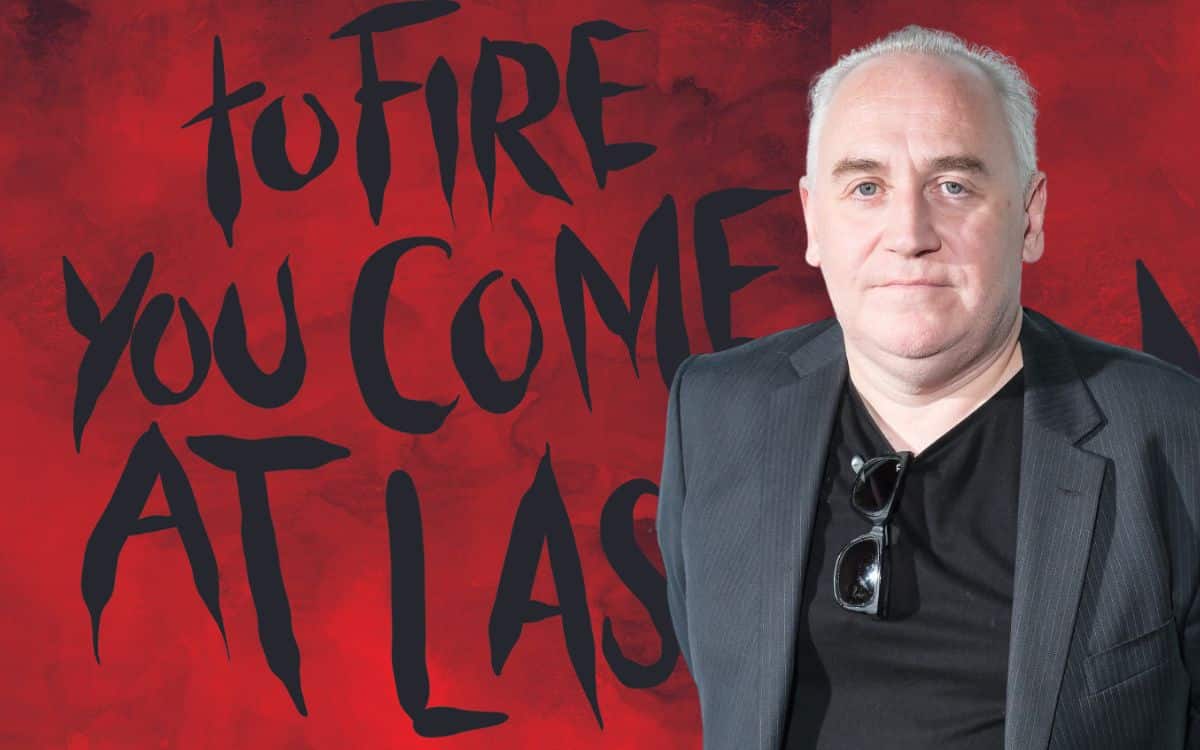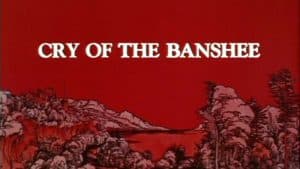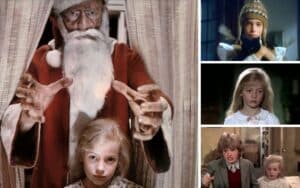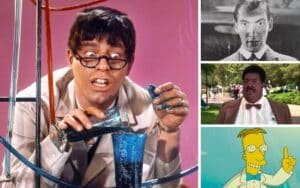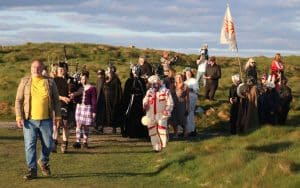Filmmaker Sean Hogan discusses his latest British folk horror film To Fire You Come At Last with Spooky Isles’ DAVID SAUNDERSON
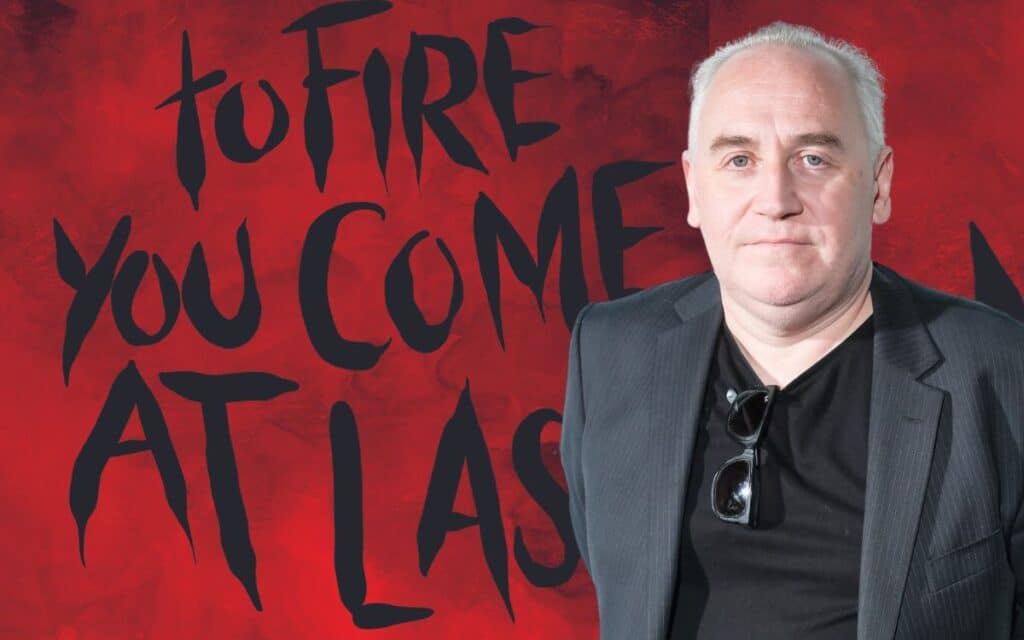
Set in 17th-century England, To Fire You Come At Last 2023 is a newly-released short folk horror film follows Squire Marlow and his men on a perilous journey to bury a coffin at night, challenging them with some very spooky events.
Writer-Director Sean Hogan tells David Saunderson about what inspired him to make the creepy black-and-white historic horror and the reason behind its enigmatic title.
Sean Hogan Interview
SPOOKY ISLES: The film seems clearly linked to the history of folk horror and British genre television, can you delve into any specific episodes or series from the past that directly influenced this project?
My intent was definitely to create something that evoked the spirit of that era, rather than to produce a deliberate pastiche.
So when I sat down to write the script, I wasn’t really thinking of any specific TV programmes per se. In fact, one of my first notes to myself was in quite a different vein: that the end result should feel a bit like if Martin McDonagh made a horror film!
That said, because of my involvement in recording commentaries for their recent BFI blu-ray releases, I’ve spent a fair bit of time over the last year rewatching the 1970’s BBC Christmas ghost stories, so I think a lot of that feel ended up seeping into the film.
I did look at Whistle and I’ll Come to You again, specifically for the use of 16mm black and white and the eerie starkness of the landscapes, and there’s probably a bit of The Exorcism in there as well: the class politics, and the fact that the vengeful ghost gets to deliver a climactic monologue from beyond the grave!
Each character in the film, from the grieving Squire Mallow to the thug manservant Pike, has unique motivations. How did you approach their development to ensure they are distinct and memorable?
Very often when I start writing a script, I’ll be working from an outline I’ve prepared in advance, meaning I’ll already have a pretty good idea of who the characters are and what the main plot points are.
However, there are occasions where all I have is the basic idea for a film, and I just start writing to find out what’s going to happen.
This was very much one of those times. I knew the film would involve a journey along a corpse road, and that each of the group carrying the coffin would have some relation to the deceased man.
But I didn’t know exactly who the men were at that point, and literally just started writing the opening scene in order to find out.
So the characters very much told me who they were, rather than the other way around!
That may sound like an odd way of doing it, but I’ve been writing for long enough now that I trust my instincts will steer me in the right direction; very often I find that’s where the best stuff comes from, rather than me overthinking things in advance.
I should also say that I hugely enjoy working with actors and want to give them interesting, memorable parts, so I’m always trying to ensure that even the smaller supporting roles get some good lines and bits of character business to get their teeth into.
The act of carrying the coffin along a haunted road is a pivotal part of the film. What significance does the “Coffin Walk” have in the story?
The film is very much structured as a journey into the heart of darkness, I suppose.
The four main characters are all flawed in various ways, and each of them has something to hide, but as the night slowly gets darker, one by one, their individual secrets begin to be revealed.
Eventually, it’s as if the characters are just wandering around in an endless black void, and one of them begins to wonder whether they might even have stumbled into Hell itself without realising it.
So the journey is really about each of them having to face a final reckoning over their past actions; that isn’t to say they necessarily all deserve what happens to them, only that each of their choices has set them on this very dark path, and the rest of it is simply a matter of the vagaries of fate.
How did you research and decide upon which pieces of ancient spooky folklore to incorporate into the storyline?
I first started reading about corpse roads about 10 years ago, and couldn’t believe that no one had really utilised any of the folklore surrounding them in a film before.
So I actually wrote a script called The Corpse Road back then, although it never got made and was nothing to do with this particular film (in fact, I eventually turned that screenplay into a novel, which will hopefully be coming out next year).
But the concept stayed with me, and when my friend Kier-La Janisse approached me about making a folk horror film, she very much wanted me to do something that was concerned with ritual belief, and in fact mentioned corpse roads as an example in her brief.
That was really all the encouragement I needed! In terms of the specific folklore, I mostly tried to use aspects that tied in with the overall plot, such as the notion that spirits can’t cross running water, or the appearance of a black hound being a portent of death (this specific legend is taken from a still-existing corpse road in Yorkshire).
I did have to cherry-pick the lore to a certain extent; for instance, there was a superstition that a dead body would corrupt any earth and soil underneath it, meaning that large flat stones were placed along corpse roads to allow the coffin bearers to put the casket down and rest.
But the events of my script meant that the coffin would inevitably have to be put down at certain moments, so I chose to ignore that particular aspect!
The film transforms from what seems like a straightforward journey to a psychological thriller. How did you navigate this transition to maintain suspense and intrigue?
I’m quite fond of horror films that take place in a single location and utilise a limited cast, as I think this can really foster a sense of rising tension and claustrophobia.
Although this film takes place entirely in the open air, I hope that it still has a similar sort of feel to it.
The idea was that as night falls and darkness slowly encloses the group, the shadows should feel almost palpable; a solid wall of blackness hemming the characters in. And given that they’re all people who have considerable cause to dislike each other, once they find themselves isolated and trapped, hostilities inevitably begin to mount.
Added to which, as I said earlier, I was really discovering the story as I went along. That meant that certain revelations in the plot were as surprising to me when I wrote them as I hope they are for an audience.
I do think there’s something to the idea that if you can manage to surprise yourself while you’re writing something, then it should also prove startling to the viewer.
The group faces many challenges during their journey. Can you discuss the process of crafting these tensions, ensuring they felt organic to the story?
It’s not something I thought too consciously about while writing the script, but I suppose the idea was to keep the two separate throughlines of tension rising in tandem: on the one hand, the series of personal revelations and conflicts that take place amongst the group, and on the other, the mounting sense that they are being stalked by an unseen someone or something.
As the story progresses, these two throughlines should start to intertwine, until a critical point is reached where they suddenly both pay off at once, and we finally learn what is truly driving the narrative.
As I say, this wasn’t something I really planned out in advance, but looking back on it, that’s clearly where my instincts led me.
So the trick was really just to augment that sense of rising suspense during the editing process: making sure the individual moments of tension worked properly, and ensuring that the gradual narrative slow build wasn’t TOO slow (we did end up trimming some of the dialogue scenes back slightly just to keep things a bit pacier).
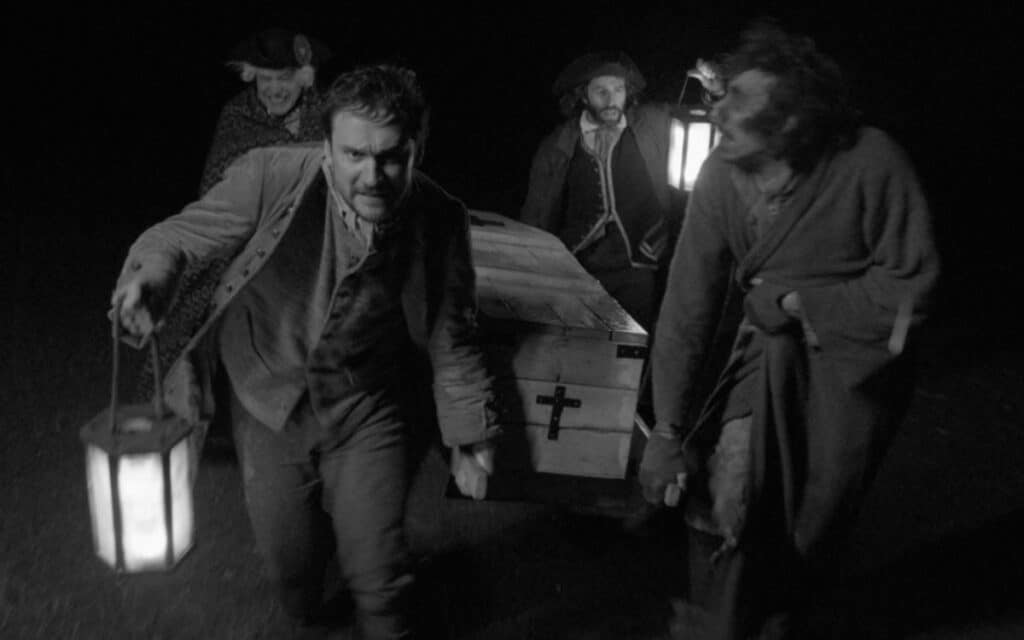
A question many might have is why the group didn’t use a horse and cart for transporting the coffin. Was this a deliberate choice?
To some degree not using a horse is a budgetary consideration: trained animals are expensive to hire and can slow shooting schedules down hugely.
However, the choice is also period accurate: at this point in history there were a limited amount of roads anyway; added to which, the whole point of corpse roads was that because of all the superstitions surrounding them, landowners did not want them running across their property.
This meant that many corpse roads frequently took very circuitous routes, sometimes across extremely inhospitable terrain that would have proved impassable for a horse and cart.
In these cases, the only option available was for people to carry the coffins on foot, often for quite significant distances.
The film’s title, To Fire You Come At Last, is deeply intriguing. I’ve seen the film and I’m not even sure what it really means. What was your the inspiration behind it and without giving too much away, how does it tie into the overall narrative of the film?
Titles are funny things. Sometimes they come really easily; at others it can be like pulling teeth. I do like to try and decide upon a title as quickly as I can, because it seems to help ground the story in my mind, for some reason.
In this particular case I didn’t have a specific title in mind myself, so I started Googling and searching for inspiration. Very quickly I came across an old song or hymn, in which one of the lines was “To flames you come at last”.
That phrase immediately leapt out at me, but I decided that “fire” would scan better than “flames”, so that quickly became the title.
Of course, I now can’t find the song in question when I go looking for it, so it’s almost as if I imagined the whole thing!
As you say, I don’t want to give too much away in terms of how the title ties in with the story, but the film does concern a group of men who might all be considered damned in one way or another; now, whether that’s because they themselves feel that they have done something unforgiveable or whether someone else believes that of them is open to question.
So I do think the title is quite fitting in that respect. On the other hand, it’s also very liberating when you have the freedom to use a title that’s a bit more poetic or ambiguous, as was the case here.
Too many film titles are deliberately generic, so it’s refreshing to be able to ignore that tendency for once.
SEAN HOGAN is a writer and filmmaker based in the UK. His feature film credits include the critically-acclaimed The Devil’s Business, The Borderlands, and the documentary Future Shock! The Story of 2000AD. He has also published several books of cinema metafiction, including England’s Screaming and its sequel Twilight’s Last Screaming (both named as one of the five best genre novels of their year by The Financial Times). In addition, he co-created (with writer Kim Newman) the anthology plays The Hallowe’en Sessions and its follow-up, The Ghost Train Doesn’t Stop Here Anymore, directing both their West End runs. He is currently developing a number of film and television projects and preparing a new novel.
Have you seen To Fire You Come At Last? Tell us your thoughts in the comments section below!
Read our review of To Fire You Come At Last 2023.

